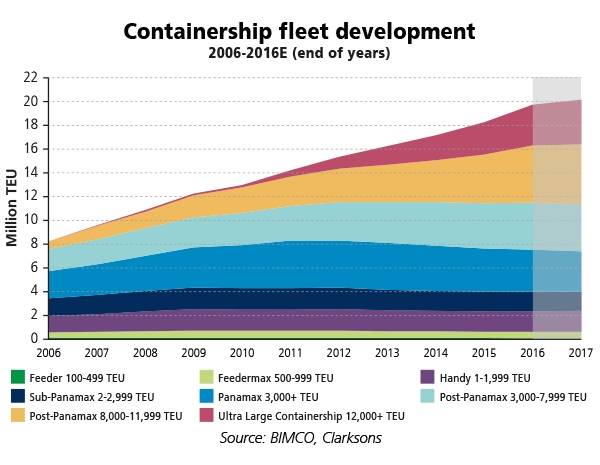Containership Fleet Nearing 20 Mln TEUs
The container shipping fleet is nearing the 20 million TEU mark, a barrier that BIMCO expects will be broken through shortly. It is expected that 2016 will see the lowest fleet growth rate on record (3.4 percent projected), but with an estimated net addition of 0.68 million TEU of capacity for the full year, the milestone could be reached in June, BIMCO said.
Over the last decade, the fleet size in TEU increased by 240 percent and reached 19.7 million TEU at the end of 2015.
However, the fleet has grown unevenly, displaying a shift to larger ship sizes and giving a one-sided focus on cutting unit costs per transported TEU by having larger ships; continuing the “bigger is better” theme.
The ultra large containership segment (ULCS) especially contributed to the growth; starting at 0.5 percent in 2007 and currently accounts for 18 percent of the total fleet, as measured by TEU capacities.
BIMCO’s Chief Shipping Analyst, Peter Sand, said, “The total containership fleet in TEU increased annually from 2006 onwards by 9 percent, in contrast to the number of ships which actually increased by only 3.7 percent on an annual basis. Despite the enormous growth of ULCS market share, the post-panamax fleet of 8,000-12,000 TEUs in relation to the total share and TEU capacity, is still the preferred shipping class, accounting for around one quarter of the containership fleet.”
According tm BIMCO, striking differences are revealed when comparing the annual growth rate for the timeframes 2006-2016 and 2011-2016: while the feeder class with less than 500 TEUs per ship, decreased by an average 4 percent per annum in relation to the time frame 2006-2016, the decline accelerated even further by an additional 1 percent in the last five years.
On the other hand, ship segments from feedermax (500-999 TEUs) to panamax (3,000+ TEUs), maintained a marginal positive annual growth between 2006-2016. However, only taking into account the timeframe from 2011 onwards, annual cutbacks of 1-2 percent occurred.
The same analogy can be applied for the timeframe from 2006-2016 for the post-panamax segment of 3,000-7,999 TEUs and 8,000-12,000 TEUs, which have grown by 8 percent and 23 percent on average, per annum respectively.
The figure which stands out the most, BIMCO said, is the annual growth of 45 percent between 2011-2016 of the ULCS (12,000 TEUs), thus backing up the trend toward larger capacity containerships.
“The trend towards higher capacity containerships stands out during the 2006-2016 period and even accelerated in the last five years,” Sand added. “Therefore, the driver towards the 20 million TEU margin was ultra large containerships and post-panamax between 8,000-12,000 TEUs.”






















